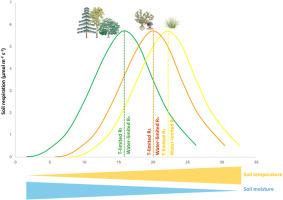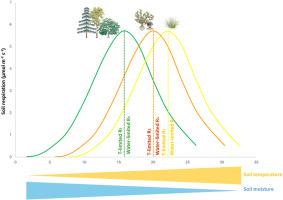Vegetation type and climate determine temperature thresholds of soil respiration across drylands
IF 10.3
1区 农林科学
Q1 SOIL SCIENCE
引用次数: 0
Abstract
Soil respiration (SR) is a key component of terrestrial carbon-climate feedbacks, yet its seasonal dynamics in drylands remain poorly understood. In mesic ecosystems, SR is primarily temperature driven, whereas in drylands it shifts seasonally from temperature to moisture control as autotrophic and heterotrophic respiration become water limited during dry periods. Identifying the soil temperature at which SR transitions from temperature to moisture limitation is therefore essential for predicting SR under climate change. We examined temperature and moisture response functions of SR across forests, shrublands, and grasslands in arid and semi-arid regions to determine the soil temperature threshold of SR (STTSR) and its drivers. Across sites, SR was positively correlated with mean annual precipitation, soil moisture, and soil organic carbon, while negatively correlated with soil temperature. The significant variability in the temperature thresholds of SR (STTSR) that was observed between sites (17.9 °C ± 5.3 °C; mean ± SD) was best explained by the mean annual temperature (MAT) at the site. Sites with higher air temperatures exhibited higher STTSR, suggesting that the compartments and metabolic processes involved in SR are adapted to local temperatures. This observed SR adaptation occurred at two different scales. Besides STTSR were positively correlated with MAT within each vegetation type, STTSR were systematically higher under short-stature vegetation types (grasslands and shrublands) compared to high-stature vegetation types (forests), suggesting that grasses and shrubs have developed the evolutionary capacity to push the STTSR to warmer temperatures and hence withstand better drought stress than trees. Our findings suggest that: (1) process-based models assuming simple linear or exponential SR-temperature relationships overestimate SR in water-limited ecosystems; and (2) projected warming and increasing water scarcity, together with shifts in vegetation dominance, may strongly modify the temperature sensitivity of SR.


植被类型和气候决定了旱地土壤呼吸的温度阈值
土壤呼吸(SR)是陆地碳-气候反馈的关键组成部分,但其在旱地的季节性动态仍然知之甚少。在mesic生态系统中,SR主要是温度驱动的,而在旱地,随着自养和异养呼吸在干旱期间成为水限制,SR季节性地从温度控制转向湿度控制。因此,确定SR从温度限制向湿度限制转变的土壤温度对于预测气候变化下的SR至关重要。研究了干旱半干旱区森林、灌丛和草地土壤温度和水分的响应函数,以确定土壤温度阈值(STTSR)及其驱动因素。各站点SR与年平均降水量、土壤水分、土壤有机碳呈正相关,与土壤温度负相关。不同站点间SR (STTSR)温度阈值的显著差异(17.9°C±5.3°C; mean±SD)最好用站点年平均温度(MAT)来解释。气温越高的地方STTSR越高,这表明参与SR的区室和代谢过程适应了当地的温度。这种观察到的SR适应发生在两个不同的尺度上。除了各植被类型的STTSR与MAT呈正相关外,矮秆植被类型(草地和灌丛)的STTSR比高秆植被类型(森林)的STTSR更高,这表明禾草和灌木已经发展出将STTSR推向更高温度的进化能力,因此比树木更能承受干旱胁迫。研究结果表明:(1)基于过程的模型假设简单的线性或指数SR-温度关系,高估了水限生态系统的SR;(2)预估的增温和缺水加剧,以及植被优势度的变化,可能会强烈改变SR的温度敏感性。
本文章由计算机程序翻译,如有差异,请以英文原文为准。
求助全文
约1分钟内获得全文
求助全文
来源期刊

Soil Biology & Biochemistry
农林科学-土壤科学
CiteScore
16.90
自引率
9.30%
发文量
312
审稿时长
49 days
期刊介绍:
Soil Biology & Biochemistry publishes original research articles of international significance focusing on biological processes in soil and their applications to soil and environmental quality. Major topics include the ecology and biochemical processes of soil organisms, their effects on the environment, and interactions with plants. The journal also welcomes state-of-the-art reviews and discussions on contemporary research in soil biology and biochemistry.
 求助内容:
求助内容: 应助结果提醒方式:
应助结果提醒方式:


